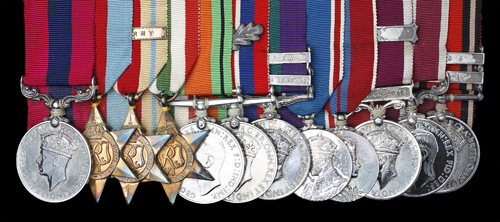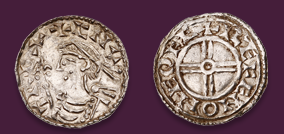
Auction: 1008 - Orders, Decorations, Campaign Medals & Militaria
Lot: 22
The Outstanding 1944 ´Anzio V.C. Action´ D.C.M. and Unique Army Best Shot Medal Combination Group of Twelve to Regimental Sergeant Major G.T. Armstrong, Grenadier Guards, Who As A Marksman is Reputed to Have Accounted For 30 Enemy Soldiers on the Anzio Beachhead; Before Fighting Side By Side With Viscount De L´Isle During His Epic Stand, 7-8th February 1944; Armstrong, Tommy Gun in Hand, Was Twice Blown Over By German Hand Grenades, But Like His Officer Refused to Give Ground. A Gifted Marksman He Had the Unusual Distinction of Winning Both the King´s and Queen´s Best Shot Medal Before Serving As a Yeoman Warder At the Tower of London a) Distinguished Conduct Medal, G.VI.R. (2022288 W.O.Cl.2 G.T. Armstrong. G. Gds.) b) 1939-1945 Star c) Africa Star, with 1st Army Bar d) Italy Star e) Defence and War Medals, M.I.D. Oakleaf f) General Service 1918-62, G.VI.R., two clasps, Palestine 1945-48, Malaya (2022288 W.O.Cl.2. G. Armstrong (D.C.M.) Gren. Gds.), clasps wired together g) Coronation 1937, engraved ´2022288 L/Sgt. G. Armstrong. 3rd G. Gds.´ h) Coronation 1953 i) Army Long Service & G.C., ´Regular Army´, with Second Award Bar (2022288 W.O.Cl.2. G.T. Armstrong. Gren. Gds.) j) Meritorious Service Medal, G.VI.R. (2022288 W.O.Cl.2. G.T. Armstrong. D.C.M. Gren. Gds.) k) Army Best Shot Medal, G.VI.R., two Bars, 1951, 1955 (2022288 R.Q.M.S. G.T. Armstrong. Gren. Gds.), the group with minor official corrections, generally very fine or better, mounted court-style as originally worn, with the following original related items and documents: - The recipient´s related miniature awards, mounted as worn, the Army Best Shot Medal lacking Bars - Regular Army Certificate of Service - Soldiers´ Service and Pay Book - Commander-in-Chief´s Certificate for Good Service (FARELF), dated 1.6.1949 - Yeoman Warder´s Warrant, complete with wax seal, dated 14.7.1964, signed Field Marshal the Earl Alexander of Tunis - Certificate of Membership, Yeoman of the Beefeater Club - A large quantity of original photographs taken from various stages of Armstrong´s career, mainly from Bisley and at the Tower of London - A large file replete with congratulatory letters and telegrams on the occasion of Armstrong winning the Best Shot Medal, 1951 and 1955, including:> - Two Telegrams from the Queen´s Private Secretary conveying Her Majesty´s congratulations on winning the Best Shot Medal for 1951 and 1955 respectively - Telegram from Queen Mary´s Private Secretary conveying the same wishes, 1951 - Telegram from the Duchess of Edinburgh, later Queen Elizabeth II, in her capacity as Colonel of the Regiment, Grenadier Guards, signed ´Elizabeth Colonel´, dated 9.7.1951 - Telegram from Lieutenant-General Sir George Gordon-Lennox, Commanding Officer Grenadier Guards, dated 7.7.1951 - Letter from Lord De L´Isle and Dudley, V.C., dated 20.10.1951 - Letter from Lieutenant-Colonel Edward Ford, Assistant Private Secretary to King George VI, 12.7.1951 - Newspaper cuttings and other ephemera (lot) Estimate £ 8,000-10,000 D.C.M. London Gazette 15.6.1944 2022288 Drill Sgt. (A/CSM) George Thomas Armstrong, 5th Bn Grenadier Guards ´During the fighting on the Anzio bridgehead the 5th Bn Grenadier Guards was almost continuously in action from the 25th January to the 9th February 1944 and this Warrant Officer was acting RSM. Throughout the period D/Sgt Armstrong was suffering severe pain from rheumatism, but refused to go sick. On the night 7/8 Feb the enemy broke through the front and heavily attacked Bn HQ, which was practically surrounded. This Warrant Officer led the defence with Tommy gun and hand grenades and by his extreme gallantry and powers of leadership succeeded in holding his position. He was twice blown over by enemy hand grenades, but this made no difference to his continued disregard for his own safety and his ability to fight the enemy with the means at his disposal. Throughout the period that the Bn was in close contact with the enemy D/Sgt Armstrong´s cheerfulness and devotion to duty were an inspiration to all with whom he came in contact, and his conduct is deserving of the highest commendation.´ 2022288 Regimental Sergeant Major George Thomas Armstrong, D.C.M. (1910-1979), born Plaistow, London; enlisted 3rd Battalion Grenadier Guards, 30.1.1928; served with the British Expeditionary Force in France, from 19.9.1939, and was evacuated from Dunkirk, 2.6.1940; advanced Company Sergeant Major 1941; served with the 1st and then the 5th Battalions, in North Africa and Italy distinguishing himself in the latter theatre in particular. Anzio Serving with the 5th Battalion as part of the 24th Guards Infantry Brigade Armstrong is believed to have accounted for some 30 enemy troops on the beachheads at Anzio; he is somewhat modest when describing the actions of the night 7/8th February 1944, when he was in company with Major William Sidney (later Viscount De L´Isle) and they faced overwhelming odds together: ´Just a few miles away we could see the Alban Hills silhouetted in the bright moonlight. They were our destination. For the time being our flanks were under attack. We slithered and squelched our way about on the wet volcanic ash. Each movement was a misery, each effort an eternity. This was Anzio, morning, February 7, 1944. We were Grenadiers, 1,000 miles from Birdcage Walk, 10 miles from the sea from which we had fought our way to this gully. For the first time in that campaign the Germans were counter-attacking. On one flank No. 4 Company had already been overun. The North Staffordshire Regiment near by towards the Buonriposo Ridge was heavily engaged. On the other flank the Scots Guards were well involved defending the station at Carroceto. The London Irish Rifles were fighting hard to keep a newly captured factory. Away on the flank we could hear a whole lot of banshee shouting from the Jerries. It was only too clear that we were next in line for attack. We were Battalion Headquarters in the gully. It sounds impressive, but if you can imagine a small number of officers and men squatting in a mud-filled, rain-filled trench, all of us speaking in whispers, with Lord Stanley (now the Earl of Derby) giving a running commentary on the show over a field telephone, you´ve got the idea. Behind us was the main road to Anzio. If Jerry had taken that he would have cut off the Scots Guards and the London Irish. His tanks would have had a clear run right the way into Anzio and there was every chance of his smashing our beachhead. We didn´t know that at the time. All we knew was that there were about 27 of us and it was our job to hold that gully. We sat and waited. I was sitting in a comparatively dry trench, priming grenades box by box and taking them up to Major W.P. Sidney, who was watching the only part of the gully through which the Germans could make a satisfactory attack.There were two men with him. One was his batman, whose name I´ve forgotten. The other was a guardsman. I had just handed the fourth box of grenades to Major Sidney´s men when two German officers appeared over the wall of the gully and started throwing everything at us. There was a patrol right behind them. Now you see a lot of heroism in war. Most of it unspectacular. Major Sidney´s courage was unbelievable and spectacular at the same time. He stood on a ridge with bullets flying around him, a perfect target in the moonlight, and loosed off round after round with his Sten gun until it jammed. Still standing up there he took grenade after grenade from his batman and flung them at the Jerry. I´m not quite sure what happened. Either there was an accident, or the Germans had thrown one of our grnades back. Whatever, happened, a grenade exploded underneath the batman-killing him and wounding Major Sidney in the head and the legs. Major Sidney didn´t falter. It was as if he was shooting pheasants. He stayed there, as calm as you please, flinging more grenades and keeping the Germans back. A German stick bomb exploded just in front of him. He caught this one with his face-but went on fighting. All this time the rest of the company were moving out from the flanks. But by the time they got there the Germans had been temporarily silenced. On the following morning we were withdrawn. I lined the men up and marched them out. It was like Trooping the Colour. They marched out, heads high - in full view of the Germans. Major Sidney - he was limping and obviously in a bad way - marched out with us. He was proud of his regiment. And we were proud of him. I´m not an officer. But I do know that it was Major Sidney´s action which saved several hundred lives - and possibly, probably, the whole Anzio operation.´ (Interview with Armstrong printed in the Daily Express, 12.4.1961, refers). Major Sidney was awarded the Victoria Cross for this action, and Armstrong, who fought along side him, also with Tommy Gun in hand and also knocked over twice by enemy grenades, was awarded the D.C.M. Post War Service and Bisley After the War Armstrong went on to serve with the regiment in Palestine, 1.2.1947-22.3.1948, and in Malaya, 4.9.1948-17.8.1949; he was awarded with a Commander-in-Chief´s Certificate for Good Service in the latter theatre; Armstrong had built up his reputation as a marksman before and during the War but it was in between postings abroad that he managed to reap rewards for his true passion, in 1951 at Bisley ´becoming the King´s Medallist and Army Champion, winning the Roberts Cup and the Army Hundred Cup and being Second in the Whitehead Cup after a tie´ (Letter from Major-General J.A. Gascoigne, included in lot, refers); this was the first time in nearly 80 years that a Grenadier had won the Army Best Shot Medal, and it was a feat which he was to repeat in 1955, having won many other cups, including Queen Mary´s Prize and the Regular and Territorial Army Cup in between; in 1955 he was also awarded the Watkin Cup and the Gold Jewel of the Army Rifle Association, both cups he had won in 1951´s virtual ´clean sweep´; his talents were later described, ´He had a very sharp eye. He never missed a trick and, to me, his hawklike eyes enabled him to become one of the most accomplished shots the British Army ever had. His eyesight was so incredible that in my shooting days I have stood behind him on the firing point and witnessed the following. He used to analyse his target shooting shot for shot and mark them up. Before, however, his shot was signalled from the butt he had already recorded the strike. I asked him how he did it, and he replied that he could actually see the flight of the bullet through the air to its MPI position. I am led to believe that he accounted for thirty Germans, sniping in the Anzio beachhead.´ (Obituary in the Grenadier Gazette refers); Armstrong´s last posting was as R.S.M. at the School of Infantry, from which he retired in 1964, having served 37 years with the Grenadier Guards; he served as a Yeoman Warder at the Tower of London, 1964-1976; he died three years into his retirement and his funeral was held at Islington Crematorium; amongst the congregation was Viscount De L´Isle.
Sold for
£13,000




